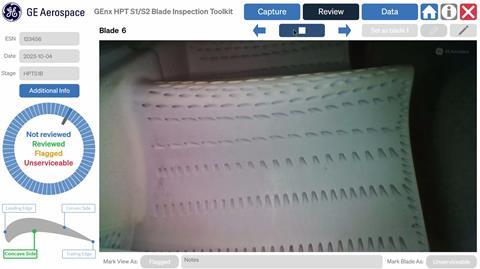AT A GLANCE:
• Finalizing plans to deploy a new AI-enabled Blade Inspection Tool (BIT) to support LEAP engine blade inspections
• Rapidly advancing development of an AI-enabled BIT for the GE9X engine to have ready when the engine enters service
• Similar to the already deployed AI-enabled BIT for the GEnx Stage 1 and 2 high pressure turbine blades, the new inspection tools for LEAP and the GE9X are expected to increase the accuracy of part inspections in half the time vs. standard borescope inspections

Building upon the success of the AI-enabled Blade Inspection Tool (BIT) for the GEnx engine – which has cut blade inspection times in half while improving the accuracy of inspections compared to standard borescope inspections – GE Aerospace recently announced plans to roll out two new similar AI-enabled inspection tools for the CFM LEAP* and GE9X engines during Aviation Week’s 2024 MRO Europe Conference in Barcelona, Spain.
WHY IT MATTERS:
With the continued growth in air passenger travel and supply chains constraints causing some delays with the delivering of new planes and engines, the aerospace sector has been experiencing a significant ramp in engine services demand. The deployment of new tools using AI could help enable faster, more accurate inspections that reduce turnaround times (TAT) while maximizing Time-On-Wing (TOW), or the time engines are in service for GE Aerospace’s airline customers.
“With the deployment of our AI-enabled BIT for the GEnx engine, we have seen inspection process times cut in half from 3 to 1.5 hours while improving quality and accuracy,” said Nicole Jenkins, Chief MRO Engineer, GE Aerospace. “We’ve been able to very rapidly apply our experience and learnings for the GEnx to develop similar AI-enabled BITs for our CFM LEAP and GE9X platforms.”
“The experience and successful track record we have had with the AI-enabled BIT for the GEnx engine has given us the confidence and know-how to expand the concept to our two most advanced commercial engine platforms,” Jenkins added. “What’s particularly notable is that with the GE9X engine, we will have this advanced inspection tool ready when the engine enters service. It shows how far we have come with integrating AI technology into services.”
HOW IT WORKS:
Similarly to how AI aids doctors in reviewing patient X-rays spot lung cancer, GE Aerospace’s AI-enabled Blade Inspection Tool (BIT) guides the selection of blade images for technicians to inspect for faster, more accurate inspections. The AI helps in obtaining consistent images, which is a key input for building predictive models based on transparent and trusted domain data.

The expanded application of AI for critical blade inspections in the CFM LEAP and GE9X is part of a GE Aerospace’s more than a decade’s long journey successfully integrating AI across its business operations. Over this time, GE Aerospace has more than doubled its investment in AI technology and has positioned the company as one of the top AI patent holders within the aviation industry.

Today, GE Aerospace is using AI to enhance everything from engine monitoring and part inspections to delivering insights for its airline customers to enable predictive maintenance measures and new ways to optimize fuel efficiency and safety.
Latest related news and information GE Aerospace, Waygate Technologies to Deliver New AI-assisted Commercial Jet Engine Borescope Inspection Solution to Enhance Defect Recognition
ABOUT GE AEROSPACE:
GE Aerospace is a global aerospace propulsion, services, and systems leader with an installed base of approximately 44,000 commercial and 26,000 military aircraft engines. With a global team of 52,000 employees building on more than a century of innovation and learning, GE Aerospace is committed to inventing the future of flight, lifting people up, and bringing them home safely. Learn more about how GE Aerospace and its partners are defining flight for today, tomorrow and the future at www.geaerospace.com.
*LEAP is a trademark of CFM International, a 50-50 joint company between GE Aerospace and Safran Aircraft Engines.























